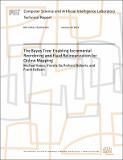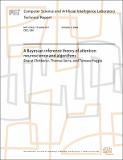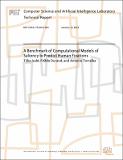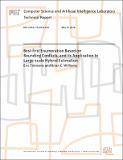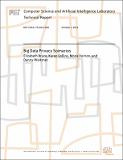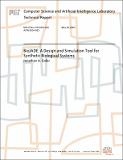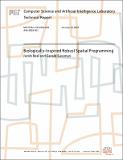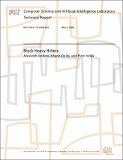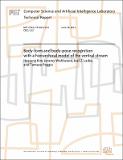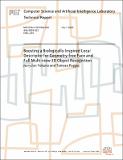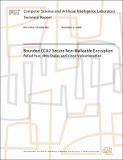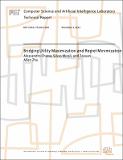Browsing CSAIL Digital Archive by Title
Now showing items 100-119 of 806
-
The Bayes Tree: Enabling Incremental Reordering and Fluid Relinearization for Online Mapping
(2010-01-29)In this paper we present a novel data structure, the Bayes tree, which exploits the connections between graphical model inference and sparse linear algebra. The proposed data structure provides a new perspective on an ... -
A Bayesian inference theory of attention: neuroscience and algorithms
(2009-10-03)The past four decades of research in visual neuroscience has generated a large and disparate body of literature on the role of attention [Itti et al., 2005]. Although several models have been developed to describe specific ... -
Bayesian perceptual inference in linear Gaussian models
(2010-09-21)The aim of this paper is to provide perceptual scientists with a quantitative framework for modeling a variety of common perceptual behaviors, and to unify various perceptual inference tasks by exposing their common ... -
Belief Programming Implementation
(2023-11-27) -
A Benchmark of Computational Models of Saliency to Predict Human Fixations
(2012-01-13)Many computational models of visual attention have been created from a wide variety of different approaches to predict where people look in images. Each model is usually introduced by demonstrating performances on new ... -
Best-first Enumeration Based on Bounding Conflicts, and its Application to Large-scale Hybrid Estimation
(2018-05-24)With the rise of autonomous systems, there is a need for them to have high levels of robustness and safety. This robustness can be achieved through systems that are self-repairing. Underlying this is the ability to diagnose ... -
Beyond the Bits: Cooperative Packet Recovery Using Physical Layer Information
(2007-05-29)Wireless networks can suffer from high packet loss rates. This paper shows that the loss rate can be significantly reduced by exposing information readily available at the physical layer. We make the physical layer convey ... -
Big Data Privacy Scenarios
(2015-10-01)This paper is the first in a series on privacy in Big Data. As an outgrowth of a series of workshops on the topic, the Big Data Privacy Working Group undertook a study of a series of use scenarios to highlight the challenges ... -
BigBand: GHz-Wide Sensing and Decoding on Commodity Radios
(2013-05-22)The goal of this paper is to make sensing and decoding GHz of spectrum simple, cheap, and low power. Our thesis is simple: if we can build a technology that captures GHz of spectrum using commodity Wi-Fi radios, it will ... -
BioJADE: A Design and Simulation Tool for Synthetic Biological Systems
(2004-05-28)The next generations of both biological engineering and computer engineering demand that control be exerted at the molecular level. Creating, characterizing and controlling synthetic biological systems may provide us with ... -
Biologically-Inspired Robust Spatial Programming
(2005-01-18)Inspired by the robustness and flexibility of biological systems, we are developing linguistic and programming tools to allow us to program spatial systems populated by vast numbers of unreliable components interconnected ... -
Block Heavy Hitters
(2008-05-02)e study a natural generalization of the heavy hitters problem in thestreaming context. We term this generalization *block heavy hitters* and define it as follows. We are to stream over a matrix$A$, and report all *rows* ... -
Body-form and body-pose recognition with a hierarchical model of the ventral stream
(2013-06-18)When learning to recognize a novel body shape, e.g., a panda bear, we are not misled by changes in its pose. A "jumping panda bear" is readily recognized, despite having no prior visual experience with the conjunction of ... -
BOOM: Broadcast Optimizations for On-chip Meshes
(2011-03-14)Future many-core chips will require an on-chip network that can support broadcasts and multicasts at good power-performance. A vanilla on-chip network would send multiple unicast packets for each broadcast packet, resulting ... -
Boosting a Biologically Inspired Local Descriptor for Geometry-free Face and Full Multi-view 3D Object Recognition
(2005-07-07)Object recognition systems relying on local descriptors are increasingly used because of their perceived robustness with respect to occlusions and to global geometrical deformations. Descriptors of this type -- based on ... -
Botz-4-Sale: Surviving Organized DDoS Attacks that Mimic Flash Crowds
(2004-10-22)Recent denial of service attacks are mounted by professionalsusing Botnets of tens of thousands of compromisedmachines. To circumvent detection, attackers areincreasingly moving away from pure bandwidth oods toattacks ... -
Bounded CCA2-Secure Non-Malleable Encryption
(2006-12-14)Under an adaptive chosen ciphertext attack (CCA2), the security of an encryption scheme must hold against adversaries that have access to a decryption oracle. We consider a weakening of CCA2 security, wherein security ... -
Bounded-Contention Coding for Wireless Networks in the High SNR Regime
(2012-08-27)Efficient communication in wireless networks is typically challenged by the possibility of interference among several transmitting nodes. Much important research has been invested in decreasing the number of collisions in ... -
Bridging Theory and Practice in Cache Replacement
(2015-12-19)Much prior work has studied processor cache replacement policies, but a large gap remains between theory and practice. The optimal policy (MIN) requires unobtainable knowledge of the future, and prior theoretically-grounded ... -
Bridging Utility Maximization and Regret Minimization
(2013-12-03)We relate the strategies obtained by (1) utility maximizers who use regret to refine their set of undominated strategies, and (2) regret minimizers who use weak domination to refine their sets of regret-minimizing strategies.

